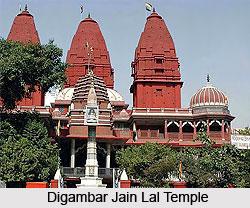 Sri Digambar Jain Lal Mandir is a Jain temple in the Chandni Chowk area of Old Delhi, located directly just across from the Red Fort (Laal Quila). Among other things, it is known for an avian veterinary hospital in a second building behind the main temple. Notable information to be shared here is that, all kinds of animal byproducts must be checked at the main gate before entry, as these aspects are against Jain precepts. It is the oldest Jain temple built in the capital, originally constructed in 1526, dating back to the rule of Mughal Emperor Aurangzeb. An impressive red sandstone temple today (the temple has undergone numerous restorations, alterations, additions in the past and was enlarged in the early 19th century), the Digambar Jain Lal Temple is popularly called as the Lal Mandir.
Sri Digambar Jain Lal Mandir is a Jain temple in the Chandni Chowk area of Old Delhi, located directly just across from the Red Fort (Laal Quila). Among other things, it is known for an avian veterinary hospital in a second building behind the main temple. Notable information to be shared here is that, all kinds of animal byproducts must be checked at the main gate before entry, as these aspects are against Jain precepts. It is the oldest Jain temple built in the capital, originally constructed in 1526, dating back to the rule of Mughal Emperor Aurangzeb. An impressive red sandstone temple today (the temple has undergone numerous restorations, alterations, additions in the past and was enlarged in the early 19th century), the Digambar Jain Lal Temple is popularly called as the Lal Mandir.
The primary devotional area is on the first floor. It can be reached by ascending the terrace after crossing the small courtyard of the temple, surrounded by a colonnade. There are a number of shrines in this area of the Digambar Jain Temple, but the main shrine is of Lord Mahavira, the 24th Tirthankara of Jainism. Born in 599 BC in the ancient republic of Vaishali (Bihar) as a prince, He abdicated all materialistic pleasures and comforts and went in search of `Moksha` (salvation). Soon he attained keval-jnana (enlightenment) and spent the rest of his life preaching to the people all over the country about eternal truth of life and ways to attain Moksha. Though some are of the belief that he was the founder of Jainism, but he was in real sense the reformer of an existing faith who recognized and presented the tenets of the religion in a form suitable to the period.
The statue of Lord Adinath, the first Tirthankara of the Jain religion is also present here, along with the shrine of Lord Parasnath, the immediate predecessor of Lord Mahavira. The temple is quite admired among the people as devotees come and make offerings such as fruits, grains, rice and candles. The Lal Mandir has a very peaceful ambience that is quite soothing especially due to the radiance of the gilded paintwork of the shrine area under the lights of butter lamps and candles. There is also a bookstore in the complex where a wide array of literatures on Jainism is available, apart from unique curios and souvenirs related to the religion. The best time to visit the temple is during the Jain festivals, which are characterized by renunciation, austerities, study of the scriptures, repetition of holy hymns, meditation and expressing devotion for the Paramatma. However, the chief festivals are- Paryushan, Samvatsari, Deepawali and Jnaan Panchami





















